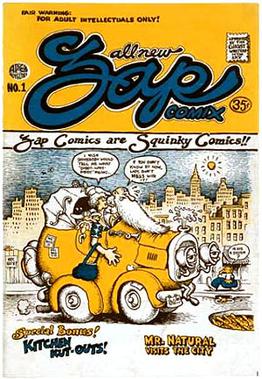
Underground comix are small press or self-published comic books that are often socially relevant or satirical in nature. They differ from mainstream comics in depicting content forbidden to mainstream publications by the Comics Code Authority, including explicit drug use, sexuality, and violence. They were most popular in the United States in the late 1960s and 1970s, and in the United Kingdom in the 1970s.

Comics is a medium used to express ideas with images, often combined with text or other visual information. It typically takes the form of a sequence of panels of images. Textual devices such as speech balloons, captions, and onomatopoeia can indicate dialogue, narration, sound effects, or other information. There is no consensus among theorists and historians on a definition of comics; some emphasize the combination of images and text, some sequentiality or other image relations, and others historical aspects such as mass reproduction or the use of recurring characters. Cartooning and other forms of illustration are the most common image-making means in comics; fumetti is a form that uses photographic images. Common forms include comic strips, editorial and gag cartoons, and comic books. Since the late 20th century, bound volumes such as graphic novels, comic albums, and tankōbon have become increasingly common, while online webcomics have proliferated in the 21st century.

Quality Comics was an American comic book publishing company which operated from 1937 to 1956 and was a creative, influential force in what historians and fans call the Golden Age of Comic Books.

An American comic book is a thin periodical originating in the United States, on average 32 pages, containing comics. While the form originated in 1933, American comic books first gained popularity after the 1938 publication of Action Comics, which included the debut of the superhero Superman. This was followed by a superhero boom that lasted until the end of World War II. After the war, while superheroes were marginalized, the comic book industry rapidly expanded and genres such as horror, crime, science fiction and romance became popular. The 1950s saw a gradual decline, due to a shift away from print media in the wake of television and the impact of the Comics Code Authority. The late 1950s and the 1960s saw a superhero revival and superheroes remained the dominant character archetype throughout the late 20th century into the 21st century.

Star Reach was an American science fiction and fantasy comics anthology published from 1974 to 1979 by Mike Friedrich.
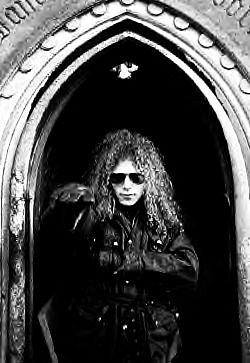
Vaughn Bodē was an American underground cartoonist and illustrator known for his character Cheech Wizard and his artwork depicting voluptuous women. A contemporary of Ralph Bakshi, Bodē has been credited as an influence on Bakshi's animated films Wizards and The Lord of the Rings. Bodē has a huge following among graffiti artists, with his characters remaining a popular subject.
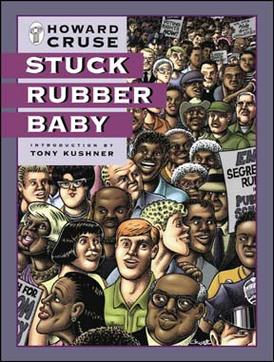
Stuck Rubber Babyis a 1995 graphic novel by American cartoonist Howard Cruse. He created his debut graphic novel after a decades-long career as an underground cartoonist. It deals with homosexuality and racism in the 1960s in the southern United States, in the midst of the Civil Rights Movement. While the book is not autobiographical, it draws upon Cruse's experience of growing up in the South during this time period, including his accidental fathering of a child, as referred to in the title.
Spider Widow is a fictional superhero character that was published by Quality Comics during the Golden Age of Comic Books. The character was created by writer and artist Frank Borth, and debuted in Feature Comics #57, which bore a cover date of June 1942. Borth continued to write and draw the Spider Widow feature until the end of its run in Feature Comics #72.
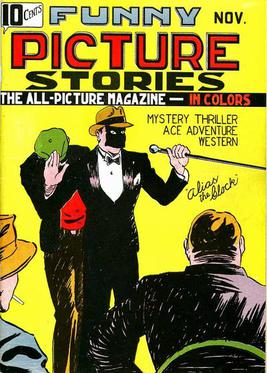
The Clock is a fictional masked crime-fighter character created in 1936, during the Golden Age of Comic Books. He was the first fully-masked hero to appear in American comic books.
Roberta Gregory is an American comic book writer and artist best known for the character Bitchy Bitch from her Fantagraphics Books series Naughty Bits. She is a prolific contributor to many feminist and underground anthologies, such as Wimmen's Comix and Gay Comix.

Trina Robbins is an American cartoonist. She was an early participant in the underground comix movement, and one of the first female artists in that movement. She is a member of the Will Eisner Hall of Fame.
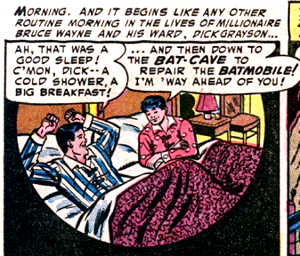
In comics, LGBT themes are a relatively new concept, as lesbian, gay, bisexual, and transgender (LGBT) themes and characters were historically omitted from the content of comic books and their comic strip predecessors due to anti-gay censorship. LGBT existence was included only via innuendo, subtext and inference. However the practice of hiding LGBT characters in the early part of the twentieth century evolved into open inclusion in the late twentieth and early twenty-first centuries, and comics explored the challenges of coming-out, societal discrimination, and personal and romantic relationships between gay characters.

Erotic comics are adult comics which focus substantially on nudity and sexual activity, either for their own sake or as a major story element. As such they are usually not permitted to be sold to legal minors. Like other genres of comics, they can consist of single panels, short comic strips, comic books, or graphic novels/albums. Although never a mainstream genre, they have existed as a niche alongside – but usually separate from – other genres of comics.

Mike Kuchar is an American underground filmmaker, actor, and artist. Kuchar is notable for his low-budget and camp films such as Sins of the Fleshapoids and The Craven Sluck.
Larry Fuller is an African-American underground comix writer, publisher, and promoter. Along with other such notables as Richard "Grass" Green, Guy Colwell, and Fuller's long-time business partner and friend, Raye Horne, Fuller made sure that the voices of black comic book creators were heard in a time when their artistic efforts were largely ignored. On the topics of race and sexuality, Fuller mastered the art of delivering social commentary in humorous form.
Comics studies is an academic field that focuses on comics and sequential art. Although comics and graphic novels have been generally dismissed as less relevant pop culture texts, scholars in fields such as semiotics, aesthetics, sociology, composition studies and cultural studies are now re-considering comics and graphic novels as complex texts deserving of serious scholarly study.
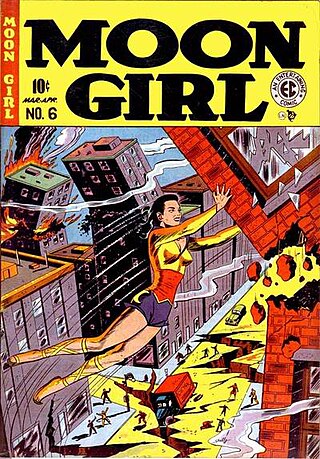
Moon Girl is a fictional character published by EC Comics from 1947 to 1949. Moon Girl is a character from the Golden Age of Comic Books and has since passed into the public domain. Her secret identity is Claire Lune, a junior high history teacher.
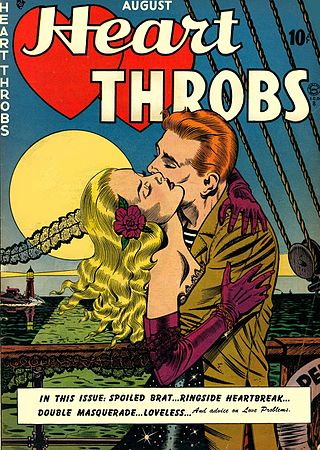
Heart Throbs was a romance comic published by Quality Comics and DC Comics from 1949 to 1972. Quality published the book from 1949–1957, when it was acquired by DC. Most issues featured a number of short comics stories, as well advice columns, text pieces, and filler. The long-running feature "3 Girls—Their Lives—Their Loves", drawn by Jay Scott Pike and inked by Russ Jones, ran in Heart Throbs from 1966–1970.
Comics has developed specialized terminology. Several attempts have been made to formalize and define the terminology of comics by authors such as Will Eisner, Scott McCloud, R. C. Harvey and Dylan Horrocks. Much of the terminology in English is under dispute, so this page will list and describe the most common terms used in comics.

The Hernandez brothers, also known as Los Bros Hernandez, are the three American cartoonist brothers Mario (b. 1953), Gilbert (b. 1957), and Jaime Hernandez (b. 1959).















